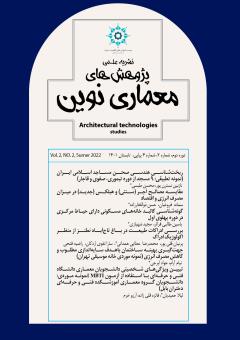بررسی ادراکات طبیعت در باغ تاجآباد نطنز از منظر اکولوژیک ادراک
محورهای موضوعی :
پرنیان قلی پور
1
,
محمدرضا عطایی همدانی
2
,
سارا تقوی اردکان
3
,
راضیه فتحی
4
![]()
1 - دانشجوی کارشناسی ارشد مهندسی معماری، دانشکده معماری و هنر، دانشگاه کاشان، کاشان، ایران.
2 - استادیار گروه معماری، دانشکده هنر و معماری، واحد کاشان، دانشگاه آزاد اسلامی، کاشان، ایران، (نویسنده مسئول).
3 - دانشجوی کارشناسی ارشد مهندسی معماری، دانشکده معماری و هنر، دانشگاه کاشان، کاشان، ایران.
4 - دانشجوی کارشناسی ارشد مهندسی معماری، دانشکده هنر و معماری، دانشگاه علم و فرهنگ، تهران، ایران.
کلید واژه: ادراک محیط, باغ ایرانی, اکولوژیک ادراک, باغ تاجآباد,
چکیده مقاله :
باغ ایرانی را میتوان یکی از شاخصترین و بهترین الگوهای منظرسازی در ایران دانست که حاصل تعامل میان انسان در مواجهه با طبیعت میباشد؛ زیرا که تعامل شکلگرفته بین انسان و طبیعت منجر به تأثیر متقابل این دو بر یکدیگر میگردد. هدف اصلی این پژوهش بررسی ارتباط بین تحریک حواس، ادراکات و هندسۀ باغ ایرانی میباشد. در حقیقت سه عامل اساسی انسان، محیط و روابط بین انسان و محیط موردبررسی قرار میگیرد تا چگونگی کنش و واکنش و تأثیرگذاری هریک را بر دیگری مشخص کند. روششناسی در پژوهش حاضر بهصورت کیفی و با رویکردی قیاسی به ارائهی ساختار کلی از یک نمونۀ جز که همان باغ تاجآباد نطنز است، به بیان مبانی نظری کلی برآمده از ادراکات محیط و روانشناسی مربوط به آن میپردازد. روش گردآوری اطلاعات نیز بهصورت مشاهدۀ میدانی و استفاده از اسناد کتابخانهای میباشد. نتیجهی حاصل گردیده بیانگر این موضوع است که باغ ایرانی بهمثابه یک کل، محصول پیوستگی مؤلفههایی است که هریک بهتنهایی معنا و مفهوم خاصی را به مخاطب القا نمیکنند و همنشینی این عناصر و مؤلفهها در کنار یکدیگر مفهوم باغ ایرانی را شکل میدهد. ازاینرو در بازآفرینی باغ ایرانی در محیط کالبدی زندگی ازجمله در شهرهای معاصر باید توجه فزایندهای به فرآیند ادراکی آن توسط انسان امروزی گردد، زیرا در این صورت میتوان به نیازهای انسان معاصر پاسخ مناسبی داد که در گام نخست موجب ارتقاء بهداشت روان جامعه گردد و در گام بعدی به پیوند حیطه معنا بیانجامد و اسباب خودشکوفایی فردی را فراهم آورد.
The Iranian garden can be considered one of the most prominent and best models of landscape design in Iran, which is the result of the interaction between humans in the face of nature, since the interaction formed between man and nature results in mutual effect of them on each other. The main aim of this study is to investigate the relationship between stimulation of the senses, perceptions and the geometry of the Iranian garden. In other words, the three basic factors of man, environment and the relationship between man and environment are examined to determine how each one acts and reacts, and influences the other. The methodology in the present study is qualitative with a comparative approach to present the general structure of a unique example, which is the Tajabad Natanz Garden. It expresses the general theoretical foundations arising from the perceptions of the environment and psychology related to it. Field observation and library documents were used to collect information. The obtained result indicate that the Iranian garden as a whole is the product of the connection of components, each of which alone does not convey a specific meaning and concept to the audience, and the coexistence of these elements and components together forms the concept of the Iranian garden. Thus, in recreating the Iranian garden in the physical environment of life, including in contemporary cities, increasing attention should be paid to its perceptual process by modern man to provide an appropriate response to the needs of contemporary man. It will improve the mental health of the society in the first step and leads to the connection in the areas of meaning and provides the conditions for individual self-fulfillment in the second step.
